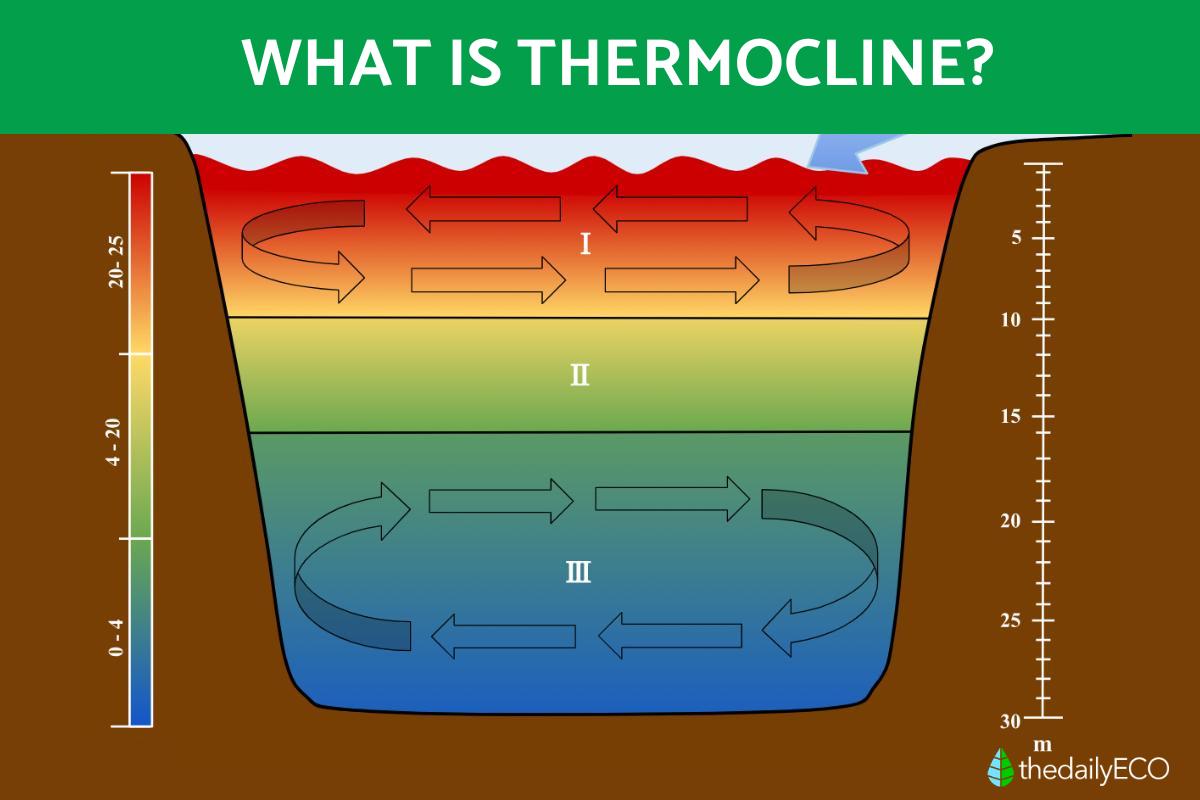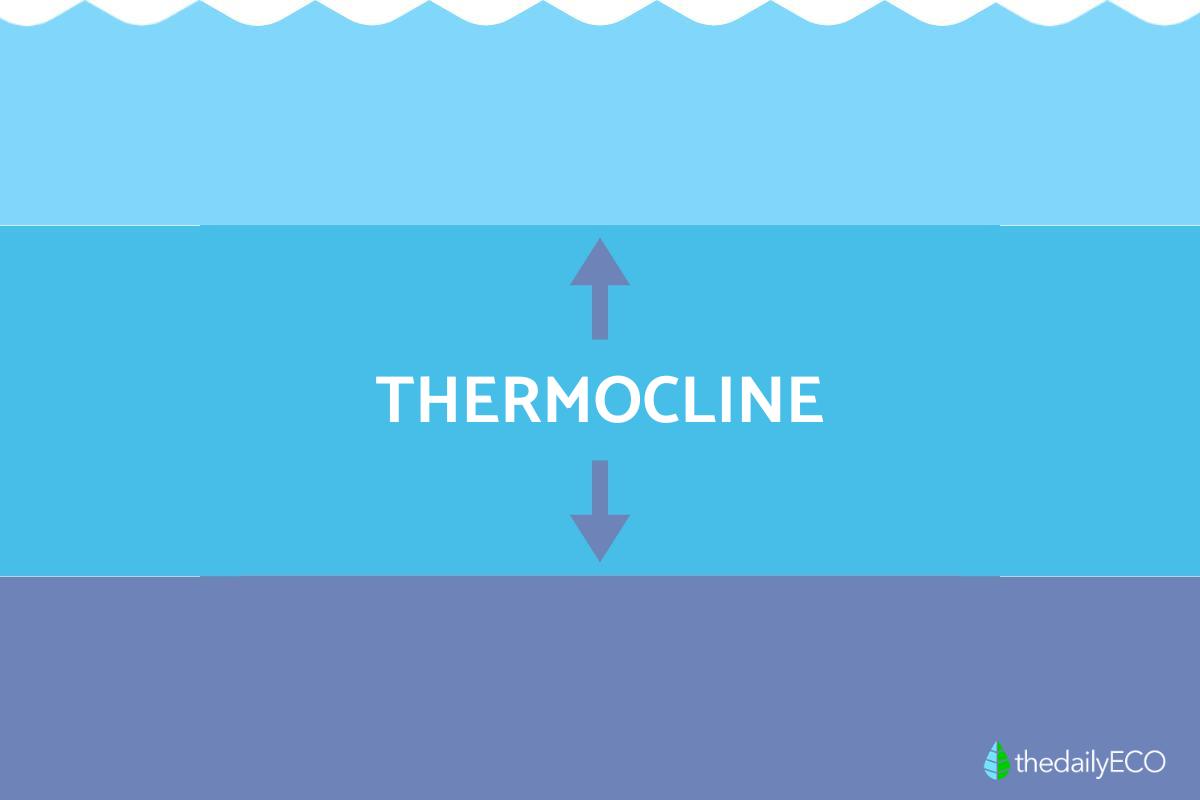What Is a Thermocline and How Is It Formed?


In the realm of fluid dynamics, a thermocline emerges as a distinct layer in a body of water where there is a rapid change in temperature with depth. This invisible boundary acts as a barrier, separating warmer, sunlit waters from the cooler, deeper layers. The presence of a thermocline plays a crucial role in shaping the structure and dynamics of aquatic ecosystems.
In the following article from thedailyECO, we delve into the concept of thermocline, examining its formation, various types, and ecological significance.
What is the thermocline?
The thermocline, observed in oceans, lakes, and rivers, is a distinctive phenomenon characterized by a vertical layer within the water column, signaling a rapid temperature change. This transition occurs abruptly between two water strata with differing temperatures, typically situated at a specific depth.
The formation of the thermocline is intricately tied to various factors, with solar radiation playing a pivotal role. Throughout the day, the water surface absorbs solar energy, intensifying heating in the surface layer. This heated layer, known as the epilimnion in lakes, resides above the thermocline. Conversely, the hypolimnion, a colder layer, lies beneath the thermocline.
During warmer seasons, the thermocline becomes more pronounced as the temperature contrast between the epilimnion and hypolimnion intensifies. In contrast, in winter, reduced solar radiation weakens or even dissolves the thermocline, fostering a more uniform vertical mixing process in the water column.
This thermal stratification is paramount to the ecological balance of the water body, influencing nutrient distribution, aquatic life, and water mixing patterns. It's important to note that the thermocline is not exclusive to freshwater bodies; it is a prevalent occurrence in oceans as well. In the oceanic context, the thermocline holds sway over the migration patterns of marine organisms and ocean circulation. Understanding the dynamics of the thermocline is crucial for comprehending and conserving the delicate ecosystems within aquatic environments.
At what depth does thermocline occur?
The depth at which the thermocline occurs varies depending on the body of water and the season.
In general, the thermocline is shallower in the summer and deeper in the winter. This is because the surface waters warm up more in the summer, which can cause the thermocline to rise in the water column.
In lakes and ponds, the thermocline typically occurs between 10 and 30 meters (33 and 98 feet) deep. However, it can be as shallow as 5 meters (16 feet) or as deep as 100 meters (328 feet) in some cases.
In oceans, the thermocline is typically much deeper, and it can occur between 100 and 1,000 meters (328 and 3,281 feet) deep. However, it can be as shallow as 50 meters (164 feet) or as deep as 1,500 meters (4,921 feet) in some cases.

Is there life below the thermocline?
Yes, there is life below the thermocline, but it is much less abundant than in the warmer, sunlit surface waters. The hypolimnion, the cold, deeper layer of water below the thermocline, is typically oxygen-depleted, making it unsuitable for many aquatic organisms. However, there are a few specialized species that have adapted to survive in this harsh environment.
One group of organisms that thrive below the thermocline are anaerobic bacteria. These bacteria do not require oxygen to survive and instead use other electron acceptors, such as sulfate or nitrate, to generate energy. Anaerobic bacteria play an important role in the decomposition of organic matter in the hypolimnion and help to recycle nutrients within the ecosystem.
Another group of organisms that can survive below the thermocline are cold-adapted fish. These fish have special adaptations that allow them to tolerate the low temperatures and low oxygen levels of the hypolimnion. For example, they may have larger gills or a higher blood oxygen-carrying capacity. Cold-adapted fish typically feed on organisms that have fallen from the epilimnion, such as dead organisms or plankton.
Enhance your understanding of thermodynamics by exploring our informative guide that unravels the enigma of temperature and heat.
Types of thermoclines
Various types of thermoclines exist, each established under specific conditions in different bodies of water. Here are some of the most prevalent thermoclines:
Seasonal thermocline:
- Varies with the seasons, most pronounced during the warmest months.
- Common in temperate climates, particularly evident in summer when solar radiation intensifies, heating the surface layer.
Permanent thermocline:
- Persists throughout the year.
- Typical in tropical regions where the surface water remains warm while deeper layers stay colder, acting as a limiting factor for vertical water mixing.
Diurnal thermocline:
- Forms and fades in a daily cycle.
- Daytime solar radiation creates a thermocline, but at night, heat loss causes the thermal layer to diminish.
- Observable in lakes and reservoirs.
Annual thermocline:
- Common in lakes, resulting from seasonal changes in solar radiation.
- Varies in intensity and depth throughout the year, influencing thermal stratification and aquatic organism distribution.
Thermocline of artificial origin:
- Generated by human activities, such as the release of hot water from a power plant.
- Can significantly impact local ecology and alter behavioral patterns of aquatic life.
The establishment and persistence of thermoclines are closely tied to factors like solar radiation, water body bottom topography, geometry, and the presence of winds. The formation of a specific type of thermocline depends on the interplay of these factors, influencing the thermal dynamics and ecological conditions of the water body.

How do thermoclines form?
The formation of thermoclines is intricately linked to the exchange of thermal energy between water and its environment, primarily propelled by solar radiation. Let's follow this process step by step:
During the day, as solar radiation hits the water surface, the water absorbs this energy, resulting in a temperature increase in the surface layer. Notably, the top layer of the water body, referred to as the epilimnion in lakes, warms more rapidly due to its direct exposure to the sun. Consequently, this uneven heating generates a temperature difference with the deeper layers.
This disparity in heating brings about a difference in water density between the warm epilimnion and the cooler layers of the hypolimnion. The less dense warm water tends to stay on the surface, while the denser cold water resides in deeper layers.
This interaction at the interface between the hot epilimnion and the cooler hypolimnion is known as the thermocline, where the most pronounced temperature change occurs. Importantly, the depth and intensity of the thermocline can vary based on factors such as solar radiation, water body depth, and other local conditions.
The topography of the bottom of the body of water and the presence of winds can also significantly influence the formation and stability of the thermocline. For instance, in deeper lakes, the thermocline may be more pronounced, whereas in shallower bodies of water, vertical mixing may be more frequent.
Transitioning to the nighttime, with the absence of solar radiation, the epilimnion loses heat, and the thermocline tends to weaken or even disappear. This nighttime cooling process is most evident in diurnal thermoclines, where the cycle of formation and dissipation occurs within a 24-hour period.
Ecological importance of thermoclines
Thermoclines are pivotal in shaping aquatic ecosystems. They create a stratification of nutrients, with the epilimnion enriched and the hypolimnion nutrient-depleted. This impacts primary productivity, as the thermocline separates the nutrient-rich surface from the deeper, less-nutrient waters.
Furthermore, thermoclines affect the behavior and habitat preferences of aquatic organisms by acting as temperature boundaries. Migration patterns, especially in species like salmon, are influenced by the presence of thermoclines, altering their routes and timing.
In terms of water mixing and circulation, thermoclines limit nutrient and oxygen exchange between layers, impacting ecosystem health. Disruptions in water circulation, influenced by thermoclines, can lead to the accumulation of pollutants or nutrient depletion.
Fascinated by the thermocline's influence on aquatic ecosystems? Expand your knowledge by exploring the puzzling phenomenon of thermal inversions.
If you want to read similar articles to What Is a Thermocline and How Is It Formed?, we recommend you visit our Environment (other) category.







